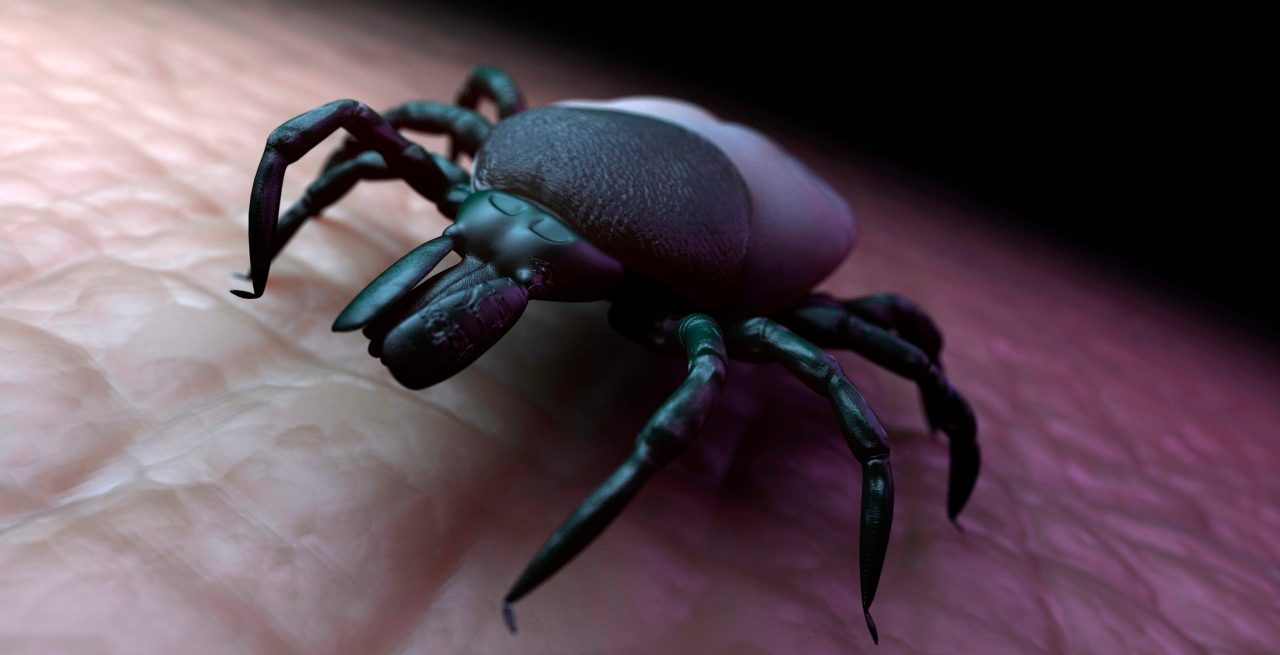Tick Bite Symptoms

Tick bite symptoms can vary but should never be ignored, especially a tick bite rash. Tickborne diseases are spreading and can be mild or life-threatening.
Ticks hang out in grassy or bushy areas, holding on to plants with their back legs. Then, when an unsuspecting animal or human brushes by, the tiny blood-sucking creatures latch on with a piercing, hook-shaped appendage called a hypostome. The National Institutes of Health (NIH) point out ticks typically don’t bite immediately. Instead, they search for warm areas of the body with thin skin (often the groin, scalp, or armpit of a human) before they clamp down to suck blood. And, once that happens, tick bite symptoms can vary.
(If you find a tick on your body, try to remove it with tweezers; grasp the tick as close to your skin as possible. When it’s removed, wash your hands and the bite site with warm soap and water, or with rubbing alcohol.)
You might barely notice a tick bite, at least, not at first. In fact, if you wonder what a tick bite looks like, think of mosquito bites. A small red bump, much like a mosquito bite, appears at the site of a tick bite or tick removal.
However, other signs and symptoms, including a tick bite rash, can occur within a month if you’ve been infected by a tickborne disease.
YOU MIGHT ALSO LIKE: Symptoms of Lyme Disease
Don’t ignore tick bite symptoms
Ticks not only feed off blood but also release illness-causing bacteria and viruses into the bloodstream. Ticks are known to spread over a dozen diseases in the U.S.,and some of these infections can have serious and potentially fatal consequences.
The incidence of tickborne infections has risen significantly within the past decade, with ticks transmitting at least 20 different infectious diseases, the NIH points out. Lyme disease represents the majority of documented tickborne infections in the U.S., with more than 30,000 cases reported each year.
Although statistics about tickborne diseases can be frightening, don’t panic and assume you’ll catch a serious illness from a tick bite. Instead, take steps to avoid tick bites in the first place. For example, stay out of grassy areas and forests unless you are wearing protective clothing and DEET-containing insect repellent, and check your body head to toe for ticks after you’ve been in locations where you could have been exposed to the creatures.
However, there’s no way to absolutely guarantee you’ll never be bitten by a tick. So, it’s crucial to know tick bite symptoms, including understanding what a tick bite rash looks like, and when to get medical help ASAP.
Don’t ignore tick bite symptoms
Tickborne diseases can result in mild symptoms you can treat at home, but they can also cause severe infections requiring antibiotics and, sometimes, hospitalization, according to the Centers for Disease Control and Prevention (CDC).
Contact your doctor immediately if you experience any of these symptoms within a few weeks after a tick bite:
- Fever or chills. With all tickborne diseases, you can experience varying amounts of fever.
- Muscle aches and pains. Tick bite symptoms associated with infections include headache, fatigue, and muscle aches. The severity of these symptoms and when they occur after a tick bite varies according to the tickborne disease.
- Tick bite rash. Distinctive rashes are a hallmark of most tickborne diseases, including Lyme disease, Rock Mountain spotted fever (RMSF), tularemia, ehrlichiosis, and southern tick-associated rash illness (STARI).
A tick bite rash indicates infection
A rash association with Lyme disease is the first sign of an infection. It usually appears within three to 30 days of a tick bite, before a fever starts. A circular, “bulls eye” rash, called erythema migrans (EM), develops in 70 to 80 percent of infected persons. EM lesions may also develop in other parts of the body several days later. Although not usually painful, a Lyme disease rash can feel warm. Without prompt antibiotic treatment, the infection can also affect the nervous system and damage the heart, the CDC warns.
The tick bite rash associated with STARI is almost identical to a Lyme disease rash. A “bulls eye” lesion develops around the site of a lone star tick bite and expands. Within a week or two after the tick bite, fever, headache, fatigue, and muscle aches may accompany the STARI rash.
About 90 percent of people infected with RMSF from a tick bite develop a rash two to five days after a fever starts. It’s most likely to appear as small, flat, pink, non-itchy spots on the wrists, forearms, and ankles. The rash usually spreads to the trunk and, sometimes, the palms and soles. A red to purple, spotted rash, caused by bleeding under the skin, is seen in 35 to 60 percent of people with RMSF. The rash doesn’t develop until the sixth day, or later, after other symptoms (including headache, abdominal pain, vomiting, and muscle pain) occur.
In about 30 percent of adults and up to 60 percent of children who contract ehrlichiosis from a tick bite, a rash develops after the onset of fever. It can be petechial (caused by bleeding under the skin) or maculopapular (red, flat bumps) and appears after the onset of fever. Other symptoms include severe headaches, nausea, diarrhea, vomiting, body aches, and confusion.
The tickborne infection tularemia doesn’t produce a typical rash. Instead, a skin ulcer appears at the site of a tick bite. Then swollen lymph glands, usually in the groin or armpit, develop. Tularemia infections can be mild or fatal, with temperatures reaching 104 degrees.
Bottom line? If you have any tick bite symptoms, contact your doctor immediately. Tickborne diseases can usually be treated successfully with antibiotics. The sooner a tickborne disease is diagnosed and treated, the more likely complications, including life-threatening ones, can be avoided.
Updated:
June 18, 2019
Reviewed By:
Janet O’Dell, RN